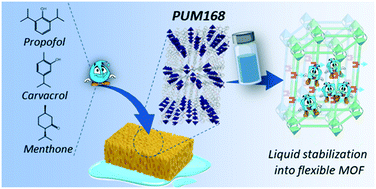Liquid active ingredients are typically less stable than their solid analogues and they are also generally associated with storage and handling problems when considered for industrial usage. However, many synthetic and natural active ingredients are liquid or low melting solids under ambient conditions, and formulation or cocrystallization might be helpful to modulate this characteristic. As an alternative, crystalline porous matrices, such as metal–organic frameworks, can be used to encapsulate the guest molecules providing them with a crystalline environment very different to what might be observed in the pure liquid phase, thus stabilizing the active compounds in the solid state. In this work, PUM168, a flexible heteroleptic MOF, has been used to encapsulate three liquid compounds (propofol, carvacrol and menthone). The nanoconfinement of the three guests has been fully investigated via SCXRD in terms of host–guest interactions and framework rearrangement as a function of the guest loading.
